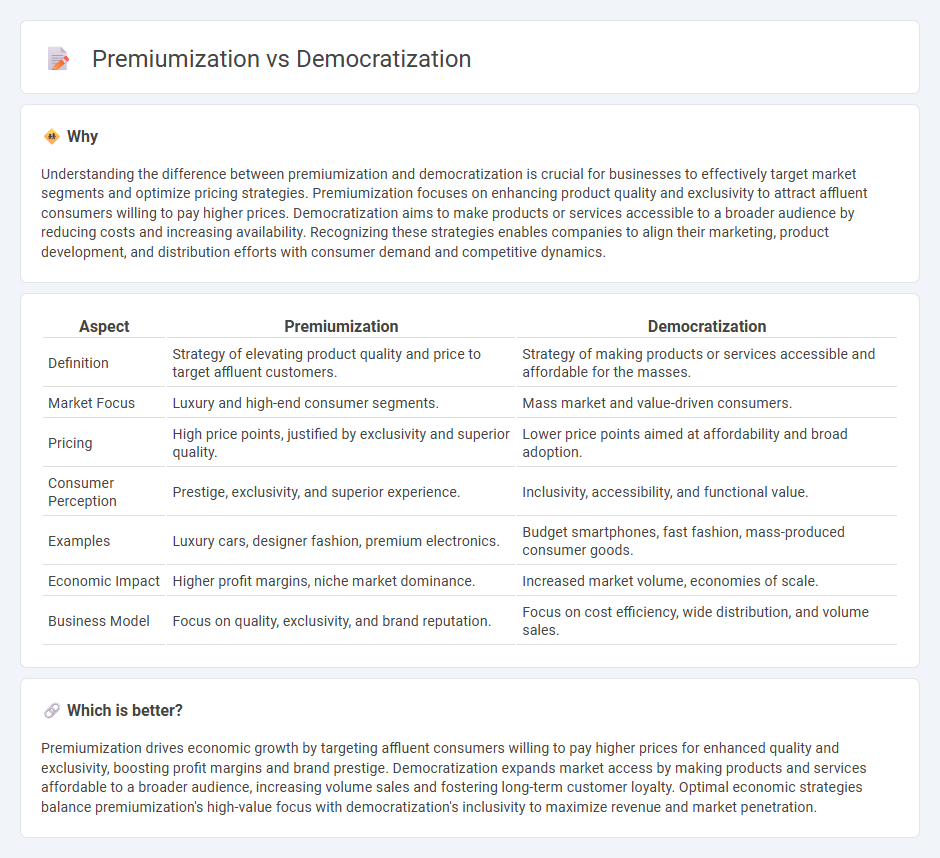
Premiumization drives economic growth by encouraging consumers to spend more on higher-quality, luxury products, boosting profit margins and brand value. Democratization expands market reach by making goods and services more accessible and affordable to a broader audience, fueling volume sales and inclusivity. Explore how the balance between premiumization and democratization shapes modern economic trends and consumer behavior.
Why it is important
Understanding the difference between premiumization and democratization is crucial for businesses to effectively target market segments and optimize pricing strategies. Premiumization focuses on enhancing product quality and exclusivity to attract affluent consumers willing to pay higher prices. Democratization aims to make products or services accessible to a broader audience by reducing costs and increasing availability. Recognizing these strategies enables companies to align their marketing, product development, and distribution efforts with consumer demand and competitive dynamics.
Comparison Table
| Aspect | Premiumization | Democratization |
|---|---|---|
| Definition | Strategy of elevating product quality and price to target affluent customers. | Strategy of making products or services accessible and affordable for the masses. |
| Market Focus | Luxury and high-end consumer segments. | Mass market and value-driven consumers. |
| Pricing | High price points, justified by exclusivity and superior quality. | Lower price points aimed at affordability and broad adoption. |
| Consumer Perception | Prestige, exclusivity, and superior experience. | Inclusivity, accessibility, and functional value. |
| Examples | Luxury cars, designer fashion, premium electronics. | Budget smartphones, fast fashion, mass-produced consumer goods. |
| Economic Impact | Higher profit margins, niche market dominance. | Increased market volume, economies of scale. |
| Business Model | Focus on quality, exclusivity, and brand reputation. | Focus on cost efficiency, wide distribution, and volume sales. |
Which is better?
Premiumization drives economic growth by targeting affluent consumers willing to pay higher prices for enhanced quality and exclusivity, boosting profit margins and brand prestige. Democratization expands market access by making products and services affordable to a broader audience, increasing volume sales and fostering long-term customer loyalty. Optimal economic strategies balance premiumization's high-value focus with democratization's inclusivity to maximize revenue and market penetration.
Connection
Premiumization and democratization intersect in the economy by influencing consumer behavior and market accessibility. Premiumization drives demand for high-quality, luxury products while democratization expands access, enabling broader consumer segments to afford and value these premium offerings. This synergy reshapes market dynamics, fostering innovation and diverse product portfolios across industries.
Key Terms
Accessibility
Democratization of products emphasizes widespread accessibility by lowering costs and simplifying user interfaces to reach a broader audience. Premiumization targets niche markets with enhanced features, superior quality, and exclusive experiences, often at higher prices. Explore how balancing accessibility and exclusivity strategies can redefine market dynamics and consumer satisfaction.
Value Proposition
Democratization emphasizes accessible and affordable products to reach a broad market, ensuring value through cost-efficiency and widespread availability. Premiumization focuses on elevating the value proposition by offering superior quality, exclusivity, and enhanced customer experiences tailored for niche segments willing to pay a premium. Explore deeper insights on how value propositions shift between democratized and premium markets to optimize your business strategy.
Consumer Segmentation
Consumer segmentation reveals distinct trends in democratization, where affordable products target mass markets, and premiumization, which emphasizes exclusive, high-value offerings for niche segments. Brands leverage data analytics to tailor marketing strategies that meet diverse consumer desires, balancing accessibility and luxury appeal. Explore how these segmentation strategies reshape product development and customer engagement.
Source and External Links
Democratization Overview - Institute of Developing Economies - Democratization is the process of establishing free and fair elections and realizing the civil liberties and political rights necessary for procedural democracy, which may involve social and economic transformations traditionally associated with modernization.
Democratization - Wikipedia - Democratization refers to the transition from authoritarian rule to a more democratic political regime, often driven by nonviolent civil resistance and grassroots movements rather than foreign intervention or armed revolt.
Democratization | Definition, Theories, & Facts | Britannica - Democratization is the process by which a political regime becomes democratic, frequently supported by an active civil society that fosters democratic habits, moderates conflict, and sometimes directly resists authoritarian rule.
 dowidth.com
dowidth.com